

Specific Gravity (SG), or the relative density of a gem material, is important to gemologists in identifying an unknown specimen, and to jewelers and jewelry lovers in matching the setting size to the gem weight.
SG is calculated as the ratio of the density of a given volume of the gem to the same volume of water. Amethyst has a SG = 2.65 which means that a cubic inch of amethyst weighs 2.65 times as much as a cubic inch of water. The range in SGs for gemstones extends from slightly above 1 to nearly 7.
One might ask, why so much variation? Basically the density of any material will be determined by the weight of the parts of which it is made (in this case various chemical elements) and how those parts are put together (are they closely or loosely packed in their crystal lattice?).
In general, gems which have heavy elements in their chemical formulas, like lead or iron, and those whose crystal structures pack the atoms tightly, have high SGs while those made of lighter elements or those with loosely packed crystals have low SGs.
An example of the atomic weight factor would be the difference between corundum (sapphire or ruby) Al2O3 and hematite Fe2O3. Aluminum = atomic weight 27, Iron = atomic weight 56. (Imagine the weight of a one inch cube of aluminum in your hand versus a one inch cube of iron)


An example of the crystal packing factor would be the case of diamond and graphite. Both have the same chemical formula, C, but in diamond those carbon atoms are much more tightly packed than in graphite, so diamond's SG = 3.5, whereas that of graphite is only 2.2.


For purposes of this essay I will somewhat artificially group gems in terms of their density as light (SG less than 3), medium (SG between 3 and 4), and heavy (SG greater than 4).
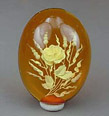


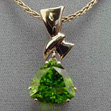


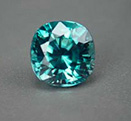
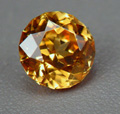
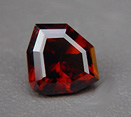
Specific gravity can be measured rather crudely just by "hefting" a gem. Plastic and most glass imitations are notably lighter than the natural gems they simulate, and many diamond simulants are quite a bit heavier than diamonds. For example, CZ has a much higher SG than diamond (5.8 as opposed to 3.5).
Savvy jewelers can often discriminate cubic zirconia from diamond by the simple hefting technique, as they are quite familiar with the weight of various sized diamonds. If a stone is too heavy for a diamond of its size, suspicion is aroused.
Along the same line, but more precise, would be the use tables of sizes and weights such as found in appraiser's and jeweler's manuals. Measuring the size of a gem and checking the expected weight for the species it is supposed to be, can often weed out simulants, although it is of no use with synthetics whose SGs are the same as their natural counterparts!
Such a table would tell you that a 6.5 mm round diamond should weigh 1.0 ct (if cut according to standard proportions) whereas a 6.5 mm round CZ is expected to weigh about 1.65 ct. For this reason, when the home shopping networks sell their CZ diamond simulants, they do so in "diamond equivalents". So a "1 ct" CZ from those sources is the size of a 1 ct diamond not the weight of one!
Here is a quote from the FAQ page of the HSN.com website:
What is Absolute™?
Absolute is HSN's exclusive brand of high-quality simulated diamonds. Absolute is often combined with precious metals and genuine gemstones to create dramatic designs. Absolute stones are listed with diamond equivalency weights - to help you compare Absolute to genuine diamonds and gemstones.
SG in Gem ID
There are two commonly used ways to determine the specific gravity of an unknown: heavy liquids and hydrostatic weighing.
Heavy liquids use the bouyancy principle that says a solid will sink in a liquid whose SG is lower, float in one whose SG is higher, and remain suspended in a liquid whose SG is equal to its own.
Sets of heavy liquids with known SGs are used to determine (within a range) the SG of unknown gems. Besides being imprecise, this method uses smelly and potentially hazardous chemicals and can damage porous gems.
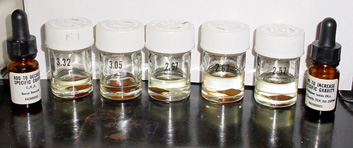
Hydrostatic weighing compares the weight of the gem in water to the weight of the gem in air with a specially rigged balance. Using these two values and a formula based on Archimedes' Principle one can calculate the SG very accurately. Although more expensive and time consuming to use than heavy liquids, there are no hazards associated with the technique and gems are not damaged as a result.
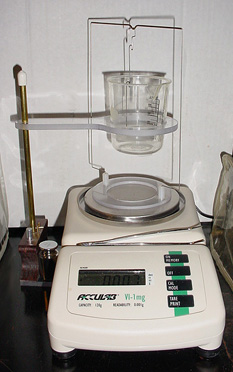
Unfortunately neither of these methods is useful with mounted stones.
An example of how a non-gemologist might benefit from this information was brought to my attention recently when an acquaintance said he wanted to get a 1 ct. round amethyst to take the place, in an old setting, of a 1 ct. round diamond that had been lost.
Since quartz has a significantly lower SG than diamond, a 1 ct. amethyst would be about 7.1 mm in diameter, too large for the 6.5 mm setting that held the diamond--> but a .80 ct. amethyst would fit perfectly!